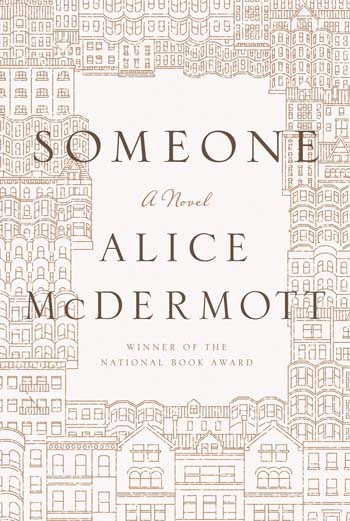In the weeks leading up to the March 13 announcement of the 2013 NBCC award winners, Critical Mass highlights the thirty finalists. Today, NBCC board member Karen R. Long offers an appreciation of Alice McDermott’s fiction finalist, “Someone” (Farrar, Straus & Giroux).

The title “Someone” seems as tepid as dishwater – flat, murky, dull. But Alice McDermott readers know to sit with her words a beat, and sure enough, “Someone” develops a tension with “No one,” and our collective sense of who matters in this world.
The “Someone” in McDermott’s exceptional seventh novel is Marie Commeford, narrator and protagonist of a modest, mid-20th century Irish-American life. It moves from a stoop in Brooklyn to a carport on Long Island. And as this respectful, luminous and unfussy novel returns readers to McDermott's familiar fictional terrain, we find cause to rejoice.
The story opens as a strange (and strangely appealing) young woman, Pegeen Chehab, emerges from the subway from Manhattan in pre-Depression Brooklyn and stops to say hello to seven-year-old Marie. Pegeen’s stocking has a run; her good spring coat is sooty; she has taken a tumble.
Twice Pegeen calls herself “amadan,” a Gaelic word that means fool. Marie is going to remember this conversation, much foolishness, and some unexpected joy. We pay close attention because the quotidian takes on a beauty here that we rarely grant it. Plenty of grit disturbs these pages, but naught is out of scale. Take Marie worrying about a school friend whose mother has suddenly died:
“My fear was that when I saw Gerty again she would resemble the neglected kids at school – kids with musty hair and black fingernails, with fallen hems and caramel-colored plugs of wax in their ears.” Writing in the New York Times, critic Leah Hager Cohen describes “the crisp purposefulness of McDermott’s prose.” That is exactly right – not a syllable is wasted; not a letter. Early on, McDermott writes, “Small city birds the color of ashes rose and fell along the rooftops.” Observe how differently that sentence might read if she used “ash.” No, the subtly variegated sparrows and wrens resemble “ashes,” not “ash.”
“Someone” is narrated episodically, almost in shards, as Marie’s memories glint into place. McDermott crafts a sly, tour-de-force chapter out of a sitting room above a funeral parlor, where Marie works and must bring word of the newly dead to Mrs. Fagin, whose son owns the establishment. Mrs. Fagin presides over a circle of women, including several nuns, who – communally – sit above the parlor and review the deceased’s life:
“Recollections were raised, sorted, compiled. If there was a good story attached to the life of the dead, whatever woman among them had it would be given the floor, and whatever part of the story was deemed, perhaps, too delicate for the old lady’s ears (or, more likely, mine) would be acted out with a series of gestures and nods and sudden silences that I quickly came to be able to interpret as readily as the rest. A finger held to the side of a nose indicated a deception, a pantomimed bottle raised to the mouth meant there was a problem with drink, the rubbing of thumb and forefinger meant money problems (usually because someone, most likely a spouse, was cheap), eyebrows raised and words falling off into a long nod indicated sex (“and he was coming home every night while she was still losing blood and . . .) – eyebrows, nod, and all the other women would cluck their tongues in sympathy.”
Marie brings upstairs the story a long neglected spinster, whose brother, a bishop, has had delivered a silk suit from Sax Fifth Avenue in which the woman is to be buried. He guesses the wrong size. The reactions of Mrs. Fagin’s circle are understated, and still smote the church. Marie’s belated understanding makes this world, executed in a mere twelve pages, perfect.
In “Someone,” Alice McDermott lifts up an unremarkable life. And in so doing, she reveals herself as an American master.
New York Times review.
Washington Post review.
NPR review.
Los Angeles Times review.
“

